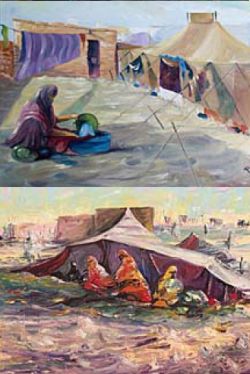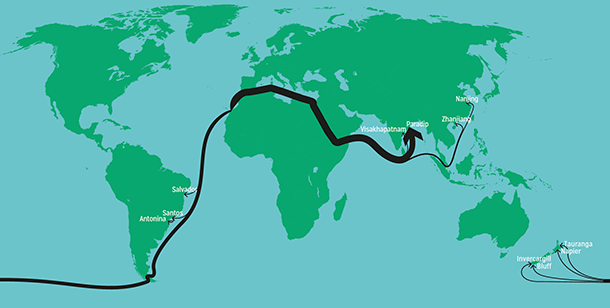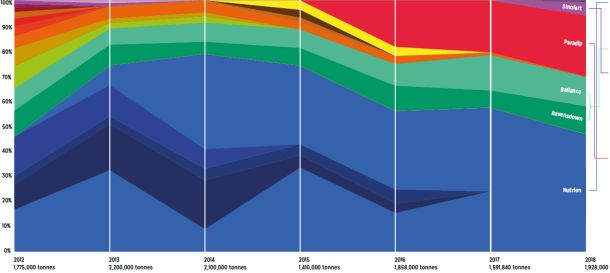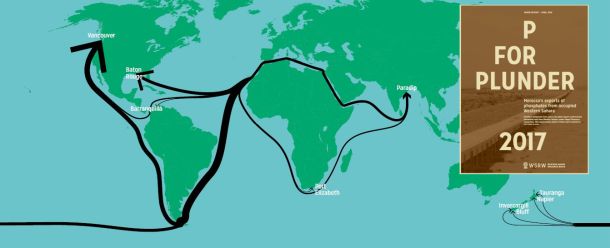
Download report here from the German NGO Kritische Ökologie
Western Sahara - The destruction of biodiversity by modern colonialism
Written by Axel Goldau[1]
Translated by Nele Saworski
With delicate fine paintings by the Sahrawian artist Fadel Jalifa [2]
Introduction
The ninth meeting of the conference of the parties of the Convention on Biodiversity (CBD) and the fourth meeting of the Conference of the parties serving as the meeting of the Parties to the Cartagena Protocol on Biosafety (COP9 and MOP4) will both take place in May 2008. Delegates from all the 190 member states of the Convention will be on the conference hosted by Germany. [3] On the conference’s agenda are
• The protection of forests and the establishing of marine reserves.
• The financing of reservation systems.
• The on-farm conservation of agricultural diversity in agro- eco- systems [In Situ Conservation] as well as the conservation of genetic diversity in crop plants and livestock in special units [Ex-Situ Conservation].
• The development of a regime for access and benefit sharing of genetic resources.
• The implementation of the agreed aim of the CBD to stop or at least decrease losses of biological diversity until 2010.
The delegates from the 143 Member states of the Cartagena Protocol will discuss questions of liability in international commerce with genetically engineered organisms.
The term ‘colonialism’ will not be mentioned neither on the Conference (COP9) nor on the Meeting (MOP4.) And the problems concerning biodiversity that result from “modern colonialism” will not be addressed.
It may or may not be a coincidence that the United Nations Conference on Environment and Development (UNCED) in 1991 / 1992 and the founding of the United Nations Mission for the Referendum in Western Sahara (MINURSO) have set in motion important processes. But so far, these processes have not led to any solutions to the problems the organisations set out to solve. The loss of biological diversity has quickened its pace. International pharmaceutical and agro- corporations threat the existence of people all around the world, and the UN completely failed to decolonize Western Sahara. The former Spanish colony is still one of 16 countries on the United Nations list of non- self governing territories. Apart from St. Helena it is the last on the African Continent. [4]
 Western Sahara and its (former) desert diversity
Western Sahara and its (former) desert diversityWestern Sahara lies in North Western Africa. Until 1975 it was colonised by Spain and after that by Morocco. Its borders are typical colonial borders, straight lines as if drawn with the ruler. The only exception is a little bend in the south west of the country. Located there are the iron mines of Zouerat. They were once a part of French West Africa. On the Congo Conference in 1884 / 85 in Berlin, France naturally did not want to leave it to Spain. Today the mines belong to the Islamic Republic of Mauritania. The only natural border of Western Sahara is the Atlantic coast in the west of the country with a length of 1,062 km. All the borders surround a territory of about 266,000 km² (about the size of the former Federal Republic of Germany), plus almost 400,000 km² Atlantic Ocean, that the United Nations Convention on the Law of the Sea (UNCLOS) grants as “exclusive economic zone”.
The territory of Western Sahara consists of the historic parts Sagiya al- Hamra in the north and Wadi adh- Dhahab (Rio de Oro) in the south. They are named after the two main wadis in the country. The wadis have a drainage areas of about 80, 000 km² (Sagiya al- Hamra) and 190,000 km² (Wadi adh- Dhahab), respectively. Water is the basic prerequisite for any development of life and it is a very precious resource in the arid areas of our planet. In the wadis' drainage areas we can find regions with long- time positive water balance. We find fresh- water lakes (Daias and Graras) and numerous natural cisterns (Gueltas) in the rock massifs. Further more, we find natural wells (Tilensi, Agla, Hassa and Bir). Fog humidity makes the Sahara a “humid-air desert”. In general we can say that Western Sahara is blessed with relatively good water supplies and in dry periods it has been an asylum both for humans and their livestock and fauna.
The Tropic of Cancer runs parallel of latitude to Dakhla. So a small part in the south of the country officially belongs to the tropics. Most however belongs to the subtropics. The whole territory is located in the transition region in between the tropics and the subtropics. Sporadic tropical summer rain and subtropical winter rain take turns.
Western Sahara is part of the West African Shield. Its mountains were formed in the Precambrian. Since then they have been in a process of erosion and by now look fined down. What’s left are so called mountain stumps (Guelb). In the north the Hamada de Tinduf, a grit and rubble plateau, reaches up to the Atlantic coast. In the south, the dunes (Erg) of the Azefal reach up to the ocean.
The History of the biosphere that we call biological evolution or just short evolution is a singular process of growing biomass on the basis of innovation and recycling. Green plants (the producers) work hand in hand with microorganisms (the reducers). As a by-product the green plants produce oxygen which is a precondition for further accretion. Among the producers (green plants and microbes) and the reducers (the microorganisms) animals and humans have taken their place as consumers. They accelerate the recycling processes and thus bio-production. In dry areas like Western Sahara the soil is poor in humus. The microorganisms that are necessary for recycling processes can be found much more in the digestive tracts of ruminants and camels than in the soil.
Because of its geographical position - the long Atlantic coast bringing cold water rich with plankton - and its topographical structure, Western Sahara experiences manifold phenomena. Flora and fauna from at least two different regions meet and species and subspecies from different areas can be found. Next to Mediterranean vegetation, we find plants of African- tropical origin as well as from the Old World arid region that stretches from the Wadi adh- Dhahab (Rio de Oro) to the Thar Desert in North-West India. On the plateaus in the east of the country we find copious Sahel landscapes with diffuse bush vegetation.
A similar phenomenon can be observed concerning the fauna. Seen from a zoogeographic point of view, Western Sahara lies between the Western Palaearctic and the Afrotropical Region. In between lies the dry Sahara-sahelian Subregion that stretches from Wadi adh- Dhahab (Rio de Oro) to the Red Sea and continues to the Arabian Peninsula and South-West Asia onto North-West India. Similar to the plants we find animals of Palaearctic origin as well as Afrotropical and Sahara-sahelian origin. On the standpipes, relicts of gone by eras, that are accessible throughout the year, a fauna has found its refuge that one would not normally associate with desert habitation.
Six middle and large sized bovid species lived in the area, way into the age of Spanish colonialism. One of Palaearctic origin is the barbary sheep (Ammotragus lervia) [5], and the five others are of Sahara-sahelian origin. The wild cat (Felis silvestris) still exists in Western Sahara. Its afrotropical relative, the giant lion, is extinct in the region. And with great probability the Sahara-sahelian cheetah (Acinonyx jubatus) is too. However, amphibians like the Palaearctic green toad (Bufo viridis), the afrotropical sub desert toad (Bufo xeros) and the sahara frog (Rana saharica) give evidence of gone by eras.
The long coast is very important, as wader birds trespass it, and some also winter there. Several species breed high up in the north of the Western Palaearctic and travel all along the western coasts of Europe and Africa. Some of them even travel all the way to Southern Africa, more than 10,000 km back and forth. Scientists have proved the existence of 65 different breeding bird species in the territory.
The ancestors of today's Sahrawian population had a very sustainable way of using and cultivating the land. Thanks to Hilde GAUTHIER- PILTERS and Anne INNA we know a lot about the way in which the nomads used the land. From the 1950 till way into the 1970’s they conducted a long- term study for which they observed Reguibat, one of the last great camel nomads in Algeria and Mauretania. [6]
Under natural circumstances Western Sahara is by no means a “bleak desert”, but an area with a very special biological diversity. The Sahrawi used to know a lot about how to maintain and utilize that diversity. The current political conditions of continuing colonisation threaten this knowledge. Under current circumstances a discussions on the fair distribution of profits gained by sustainable use of the land and its natural resources, is almost impossible.
Article 8 (j) of the CBD explicitly states the importance of traditional knowledge and indigenous local community life for the preservation of biological diversity. But only few indigenous communities around the world have successfully managed to protect their cultivated diversity and knowledge from bio-piracy. Today at least some of them have a lobby and are organised in the International Indigenous Forum on Biodiversity. They at least have an observer status on the CBD. But the Sahrawi are not organised and cannot hope for any support at the Convention.
Spanish colonialism’s influence on biodiversity
At the end of the 19th Century the European colonial forces divided the African continent among themselves. The Chancellor of the German Empire Count of Bismarck thought it wisest to ensure Germany’s colonial interest on the basis of a treaty.
So in 1984/1985 he staged the Berlin Congo Conference. On that conference the colonial borders were drawn a new, mostly with the ruler on the map. At that time Spain had a place of trade in what is today Dakhla. Spain had a great advantage in the negotiations, because it had already signed a treaty with Cheikh Ainin, who was a Sahrawian Notable. Cheikh Ainin of course hadn’t signed the treaty because he liked the Spanish so much. It had been pure calculus, as Cheikh Ainin thought it a good strategy to keep the French at bay, who were very ambitious in the region.
Cheikh Ainin was very influential in the Sahara Region as he had the authority to unite the different tribes under his command. The Sahrawian tribes even managed to maintain food sovereignty because their traditional ways of cultivating the land were so effective. The food sovereignty was an important factor for the Sahrawi’s' independence in spite of the occupation.
This was the reason why the colonial authorities together with the French colonial troops systematically began to destroy Sahrawi agriculture. They shot down the livestock, poisoned wells and demolished gueltas. These colonial crimes effected a rapid decrease of agricultural production. Dry periods followed, that enforced the process. The colonial forces pretended to show grandeur by sending food aid, while on the other hand ruining further Sahrawian agricultural activity. The prejudice of “infertile deserts” fitted this colonial concept very well. Natural factors were said to be the reason for the marginal food situation, while the colonial forces tried to cover up their crimes and present themselves as saviours of the population.
After the Spanish colonialists had gained control over the whole territory they started destroying the large- sized fauna. Animals like the scimitar-horned oryx (Oryx dammah) and the addax (Addax nasomaculatus) [8] were extinguished in trophy hunts with automatic weapons and automobiles adapted to desert ground. And without large sized herbivores there will be no large sized carnivores.
In 1957 VALVERDE [9] published a study on the fauna. Even then he could not find proof that lions still existed in the colony. He did however find cheetahs (Acinonyx jubatus hecki), the North African subspecies. But it is most certain that they are extinct by now as well.
But even among the colonial officers were man like Major Estalayo, who wasn’t only very popular with the Sahrawian people, but who also helped the mohor gazelle (Gazelle dama mohor) survive. According to VALVERDE the animals - about the size of the fallow deer - were still relatively common in the middle of the 1950, especially in the southern part of the country. This was due to protective measures that the Spanish had taken. But the last specimen was shot in 1968 in southern Western Sahara. At the time they were completely extinct in their once large area of distribution that had been Tunisia, Algeria, South Morocco, Western Sahara, Mauretania and Senegal.
Luckily, at the time Mayor Estalayo still owned eight mohor gazelles that his Sahrawian soldiers had given him as presents. In 1971 Prof. VALVERDE convinced the Mayor to send his gazelles to Spanish Almería. That was three years after the last gazelle was shot in the southern country and four years before Moroccan tanks should take the country.
Moroccan Colonialism’s influence on biodiversity
At the moment the international community’s eyes are on the violations of human rights by the Moroccan colonial authorities. Morocco imposes severe punishment on every woman, or man, or even child, who insists on the right to self- determination. The kingdom of Morocco blocks WebPages, shields independent observers and evicts international reporters, trying to hide its repressive actions in the colony from the international public. Scientific research as all other forms of independent research is severely impeded. So it is not easy to ascertain how Moroccan colonialism has influenced the country’s biodiversity.
In 2002 the Sahrawian President and Secretary General of the Frente Polisario appealed to the World Summit on Sustainable Development (WSSD). In his desperate cry for help, Mohamed Abdelazis accused the Moroccan colonial authorities of destroying the natural resources, by exploiting the mineral resources in Western Sahara. In his letter, the president claims that while the world gathers to stop the destruction of biodiversity on our planet, “the Moroccan occupational forces lead a continuing war against all forms of life in Western Sahara. Gazelles, bustards and many reptiles have already vanished from our country.” He accused the Moroccan occupational forces of pursuing a policy of the “scorched earth”. He pointed at the poverty, the unemployment and the discrimination that the Sahrawian people were suffering under the Moroccan occupation. He also pointed out how the oceans were currently pillaged by overfishing. (Quotes taken from Euro- Press/ Johannesburg 29.08.2002)
Morocco’s invasion into Western Sahara, the bombardment, the long lasting war, and the placing of mines everywhere have destroyed the basis of life for flora, fauna and humans alike. It has also torn apart families. Since the wall was built in the 1980’s the land is divided and the Sahrawi nomads are not longer able to travel with their livestock as they used to.
Plus, the presence of soldiers, armed with automatic weapons and automobiles adapted to desert ground, has never served fauna well. The occupants' settlement policy turns the Sahrawian people into a minority in their own country and the Moroccan authorities force them to settle, so they are easier to control.
The Moroccan occupation policy leads to urbanisation and to the decline of Sahrawian nomad culture. Big irrigation projects for agricultural use have a destructive influence on the water balance in the area as they lead to salinization. “Successful” irrigation projects are an encumbrance to pastoral livestock-breeders and they accelerate the process of desertification. [10]
The occupied areas are to the most part insulated from the international public, and scientific research is constricted. The Kingdom of Morocco, that receives its military budget also from the Saudi- royal dynasty, is said to have allowed Saudi “hunting parties” to go on gazelle hunt in the occupied territory. Not a long time ago Western Sahara Resource Watch published photos of a Saudi Arabian bird hunting expedition in occupied Western Sahara. [11]
Up to now the Moroccan maraud seems to be limited to the mineral resources in Western Sahara. Morocco seeks natural gasoline and oil on- and offshore - but until now without great success. It is quite possible that the kingdom will direct its exploitational ambitions to Western Sahara’s biological diversity.
The kingdom of Morocco is a founding member of the “Green OPEC” a pan- African union of 15 African, mostly francophone states. As early as July 2006 this organisation was founded under the name Pays Africains Non Producteurs de Pétrole (PANPP) (Non- oil producing African countries). Their aim was to promote the production of agro- fuels and so profit from the current agro fuel boom. According to FAO 6% of the Moroccan population suffer a lack of food [13], and the high rising prizes for cereals have already lead to “disturbances” in the kingdom.
Where should fields for possible agro fuel production in Morocco come from? And is it not possible that, if neither natural gasoline nor oil is found in Morocco and its colony, the Moroccan government should try “renewable resources” in the desert.
Morocco and the Convention on Biodiversity
The Kingdom of Morocco has been a party of the CBD since 21.08.1995 by ratification [15]. But Western Sahara is not. It’s still on the United Nations list of non self governing territories. [16] The CBD at least is able to differentiate between the kingdom and Western Sahara on their maps. [17] That is not the case however for the EU. To please Morocco the EU agreement on fishery leaves the southern border of the area concerned undefined.
The parties of the CBD are obligated to give regular reports on the state of biodiversity in their territory. But Morocco doesn’t differentiate between its own territory and occupied Western Sahara. In addition to that the kingdom has also been ignoring all resolutions that were passed by the United Nations Security Council and the UN general assembly and it also ignores a decree passed by the International Court of Justice that contradicts all claims by the kingdom on Western Sahara.
At least concerning the fauna the Moroccan national report shows an embarrassing lack of accuracy and care. To name some Examples:
Big carnivores are listed as
- Panter- (Panthera pardus) and
- Leopard (Acinonyx jubatus)
In fact ‘panther’ (not panter) and ‘leopard’ are synonymous terms for the species Panthera pardus. Acinonyx jubatus is the scientific term for the cheetah, (among the large sized cats the one best adapted to open landscapes).
But it amounts to a political scandal that the dama gazelle (Gazella dama) is listed as a species close to extinction, along with the remark. “It concerns especially species of large mammals characterized generally by a diurnal activity and easy to hunt down.” As mentioned above the western subspecies of the dama gazelle had been extinct everywhere. Only in Western Sahara some did survive because they were sent to a conservation-breeding program in Almería / Andalusia.
By now, dama gazelles have been re-established in South Tunisia, in Senegal and in the Souss- Massa Reserve in South Morocco. Morocco is obviously not able to guarantee the survival of animals the kingdom itself has reintroduced to the area. It should also be noted that the dama gazelle is a very fast running animal. Dama Gazelles are certainly not “easy to hunt down.” Not unless the hunters have automatic weapons and desert adapted automobiles. Only the Moroccan “security forces” have such equipment.
Conclusion
The first voyagers from Portugal and Castile reached the Western Sahara Coast in the 14th century. They were seeking gold and men. European countries imported their first slaves from Western Sahara. Still the Sahrawian tribes were able to maintain control over the area until the beginning of the last century. It would be wrong to romanticize the relationship of the Sahrawian tribes and black people in the Sahel- region. It involved war, robbery, murder and slavery. Because they had camels the dominant tribes were much more apt to the climate and were able to control commerce across the Sahara. They also advanced far into the Sahara desert and into the Sahel and were not stopped until they met the tsetse fly. But for all that it had been a peaceful coexistence between man and nature.
Great destruction and evisceration started when the Spanish and Moroccan occupants took the country. But without economic, military and political help from the West- especially France and the USA - Morocco would not have been able to pursue their plans in Western Sahara.
The occupation of Western Sahara by the Kingdom of Morocco has been and is still against international law and it is one of the main obstacles to sustainable development in Maghreb. Several international institutions and conventions have been concerned with Western Sahara or at least should be. Among them are the United Nations (in the region poorly represented by MINURSO), the CBD, the United Nations Convention to Combat Desertification (UNCCD), the Convention on the Conservation of Migratory Species of Wild Animals (CMS) and the United Nations Convention on the Law of the Sea (UNCLOS). Neither of these has managed to stop the exploitation of Western Sahara. But they can function as platforms for our commitment as active members of a civil society. Without this commitment there will be no end to the colonial exploitation in Western Sahara and no sustainable development in Maghreb will be possible.
Acknowledgment
We kindly thank the Foundation Stiftung Umverteilen (Berlin/Germany), the Association de soutien à un référendum libre et régulier au Sahara Occidental (Arso, Delémont/Switzerland) and Western Sahara Resource Watch (WSRW, international) for their friendly cooperation.
Annotations
[1] Institute for Applied Cultural Research / Critical Ecology Magazine and member to WSRW
[2] Fadel Jalifa is Head of the Centre for pictorial arts of the Olaf Palme School in the Sahrawian Refugee Camps where he teaches modern arts. His works reflect the reality of life within its current socio-cultural and political context.
[3] http://www.cbd.int/
[4] http://www0.un.org/Depts/dpi/decolonization/trust3.htm
[5] Term for fauna if not otherwise mentioned, according to IUCN-redlist: www.redlist.org
[6] Hilde GAUTHIER-PILTERS & Anne INNIS DAGG (1981): The Camel – Its Evolution, Ecology, Behavior, and Relationship to Man; Chicago / London
[7] http://www.cbd.int/convention/articles.shtml?a=cbd-08
[8] According to IUCN: Regionally extinct (uncertain origin) for Western Sahara
[9] VALVERDE, J. A. (1957): Aves del Sáhara Español - Estudio Ecologico del Desierto; C.S.I.C. Madrid
[10] http://www.pastoralpeoples.org/
[11]http://wsrw.org/index.php?parse_news=single&cat=105&art=608
[12]http://www.grain.org/seedling/?id=481
[13] http://www.fao.org/es/ess/faostat/foodsecurity/Countries/EN/Morocco_e.pdf
[14]http://www.eltiempo.com/internacional/latinoamerica/noticias/ARTICULO-WEB-NOTA_INTERIOR-4095792.html
[15] http://www.cbd.int/countries/?country=ma
[16] http://www0.un.org/Depts/dpi/decolonization/trust3.htm
[17]http://www.cbd.int/countries/?country=ma
[18] http://ma.chm-cbd.net/biodiversity/faun_flor
Saharawi government launches climate plan
Here is the Saharawi people’s contribution to the global fight against climate change, presented at a side-event of COP26 today.
New report: Western Sahara phosphate trade halved
The export of phosphate rock from occupied Western Sahara has never been lower than in 2019. This is revealed in the new WSRW report P for Plunder, published today.
New report on Western Sahara phosphate industry out now
Morocco shipped 1.93 million tonnes of phosphate out of occupied Western Sahara in 2018, worth an estimated $164 million, new report shows. Here is all you need to know about the volume, values, vessels and clients.
New report on contentious Western Sahara phosphate trade
Morocco shipped over 1.5 million tonnes of phosphate out of occupied Western Sahara in 2017, to the tune of over $142 million. But the number of international importers of the contentious conflict mineral is waning, WSRW's annual report shows.



